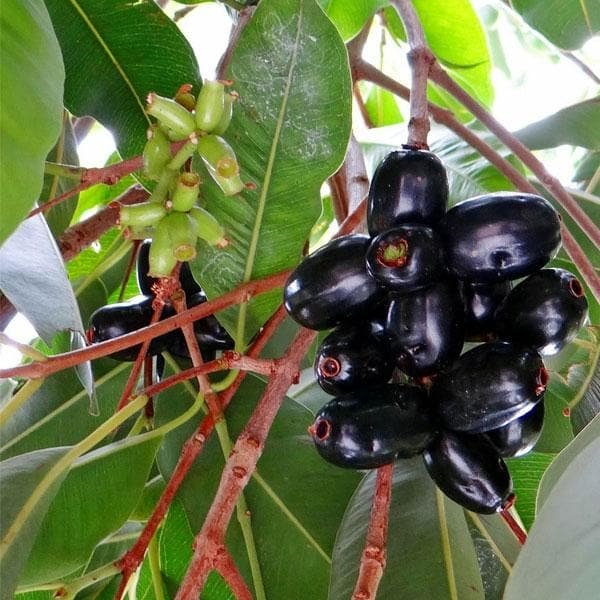Description
JAMUN GRAFTED PLANT – A COMPLETE DESCRIPTION
The Jamun (Syzygium cumini), also known as black plum, Indian blackberry, or java plum, is a tropical evergreen fruit-bearing tree that is native to the Indian subcontinent. It belongs to the family Myrtaceae and is widely grown for its nutritional, medicinal, and ornamental value. The Grafted Jamun Plant is a superior horticultural product created by grafting desirable Jamun scions onto healthy rootstock, resulting in early fruiting, higher yield, uniform quality, and true-to-type fruit characteristics.
1. Introduction to Grafted Jamun Plant
Grafting is a horticultural technique in which the tissue of one plant is inserted into another so that the two sets may continue their growth together. In the case of the Jamun plant, grafting helps overcome the limitations of seed propagation such as genetic variability, long gestation period (up to 8–10 years), and uneven fruit quality.
A grafted Jamun plant usually starts bearing fruit within 2–3 years, as opposed to seed-grown trees which may take up to a decade. This makes grafted plants highly suitable for commercial cultivation, small farmers, and home gardeners seeking faster returns.
2. Botanical Features of Jamun
- Scientific Name: Syzygium cumini
- Family: Myrtaceae
- Common Names: Jamun, Jambolan, Black Plum, Java Plum, Indian Blackberry
- Plant Type: Evergreen tree
- Height: Can grow up to 30–35 feet, though grafted varieties may be pruned to maintain a smaller canopy
The leaves are oblong, glossy, and dark green, exuding a pleasant aroma when crushed. The flowers are small, light yellow, and appear in clusters during spring. The fruit is oblong to oval, turning from green to pink to deep purple or black upon ripening.
3. Benefits of Grafted Jamun Plant
a. Early Fruiting
One of the biggest advantages of grafted Jamun plants is their early bearing. Farmers and gardeners can start harvesting fruits as early as the second or third year after planting.
b. Uniform Quality
Since grafted plants are clones of a known variety, they ensure consistent fruit size, taste, color, and yield.
c. True-to-Type Characteristics
Grafted Jamun retains the exact genetic characteristics of the mother plant, ensuring no surprises in taste or size.
d. Disease Resistance
Selected rootstocks used for grafting are often more resistant to pests, diseases, and adverse soil conditions than seed-grown plants.
e. Space Efficient
Due to their controlled growth and smaller size, grafted Jamun plants are ideal for urban gardening, containers, and high-density orchards.
4. Soil and Climatic Requirements
Jamun thrives well in a wide range of soils but prefers well-drained, loamy soil rich in organic matter. It can tolerate both acidic and slightly alkaline soils (pH 6.0 to 8.0). The tree is drought-tolerant once established but performs best with regular watering, especially during flowering and fruiting.
Climatically, Jamun requires subtropical to tropical conditions. It can withstand high temperatures and moderate frost. Ideal temperature ranges between 25°C to 35°C.
5. Planting and Care
a. Planting Time
The ideal planting time is during the monsoon season (June to August), though it can also be planted in early spring with proper irrigation.
b. Spacing
Plant grafted Jamun at a spacing of 6 to 8 meters apart if grown for commercial purposes.
c. Watering
Young grafted plants need regular watering to establish roots. Mature trees are moderately drought-tolerant but benefit from irrigation during dry spells.
d. Fertilization
Apply organic compost or well-rotted manure at the base once or twice a year. Supplement with NPK fertilizers in small quantities during the growing season.
e. Pruning
Minimal pruning is required; remove weak, diseased, or crossing branches. Shape the canopy to allow sunlight and air circulation.
6. Flowering and Fruiting
Jamun flowers between March and April, and the fruits mature by June to August. The fruit is fleshy, juicy, and has a sweet-astringent flavor with a slightly sour aftertaste. It contains a single seed and is rich in vitamin C, iron, calcium, antioxidants, and anthocyanins.
Grafted Jamun trees produce fruit with better taste and higher pulp content, making them excellent for both table consumption and value-added products like juices, jams, vinegar, and wine.
7. Health and Medicinal Value
Jamun is highly valued in Ayurveda, Unani, and traditional medicine systems. Its fruit, seed, bark, and leaves are used to treat various ailments:
- Diabetes Management: Seeds contain jamboline, which helps regulate blood sugar levels.
- Digestive Health: The astringent properties of the fruit aid in digestion and reduce acidity.
- Heart Health: The antioxidant properties support cardiovascular function.
- Immunity Booster: High in vitamin C and antioxidants.
- Anti-inflammatory & Antibacterial: Used in natural remedies for oral and skin infections.
8. Common Varieties Suitable for Grafting
- Goma Priyanka: A dwarf, high-yielding, early-bearing variety from Gujarat.
- Raj Jamun: Large-sized fruits with excellent taste.
- Paras Jamun: Known for heavy bearing and uniform fruiting.
- Seedless Jamun (developed by some research institutions): Contains tiny or no seeds, with enhanced pulp quality.
9. Pests and Diseases
Jamun is relatively hardy but can occasionally be affected by:
- Fruit fly: Lay eggs in ripening fruit.
- Leaf spot and anthracnose: Caused by fungal infections.
- Stem borer: Insects bore into stems in young plants.
Preventive measures include:
- Timely pruning of affected branches
- Application of neem oil or organic insecticides
- Maintaining proper plant hygiene and soil health
10. Conclusion
The Grafted Jamun Plant is a game-changer for both commercial and hobby growers. It combines the robustness of traditional Jamun trees with the efficiency and productivity of modern horticulture techniques. By providing early fruiting, superior fruit quality, and higher yields, grafted Jamun plants are a smart investment for farmers and gardening enthusiasts alike.
Whether you’re interested in cultivating for profit or personal health benefits, choosing a grafted Jamun plant ensures faster growth, consistent production, and the opportunity to enjoy one of nature’s most nutritious fruits right from your backyard.





 Amla, Tree for Bharani Nakshatra, Aries or Mesh Rashi - Plant
Amla, Tree for Bharani Nakshatra, Aries or Mesh Rashi - Plant 

Reviews
There are no reviews yet.